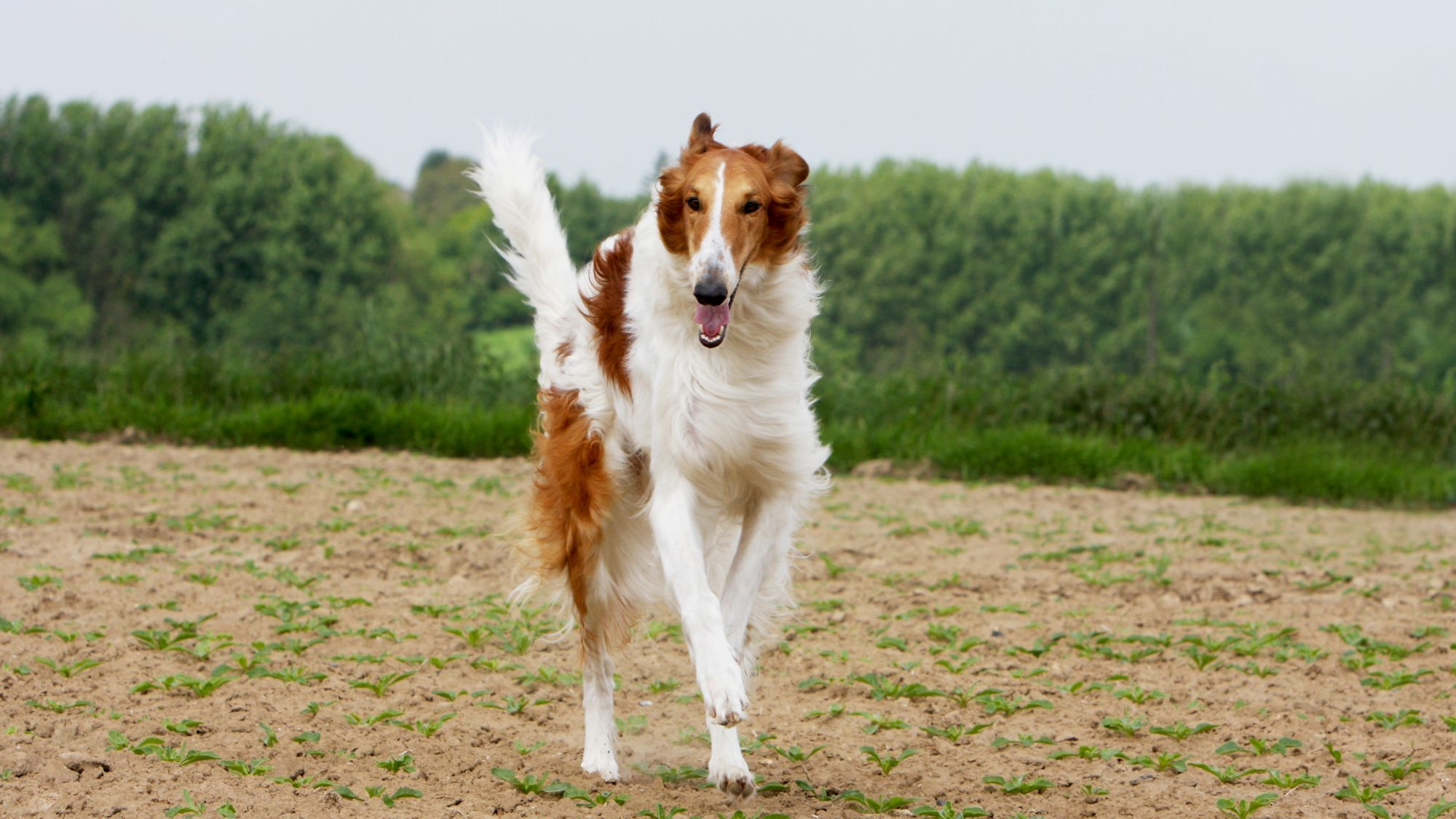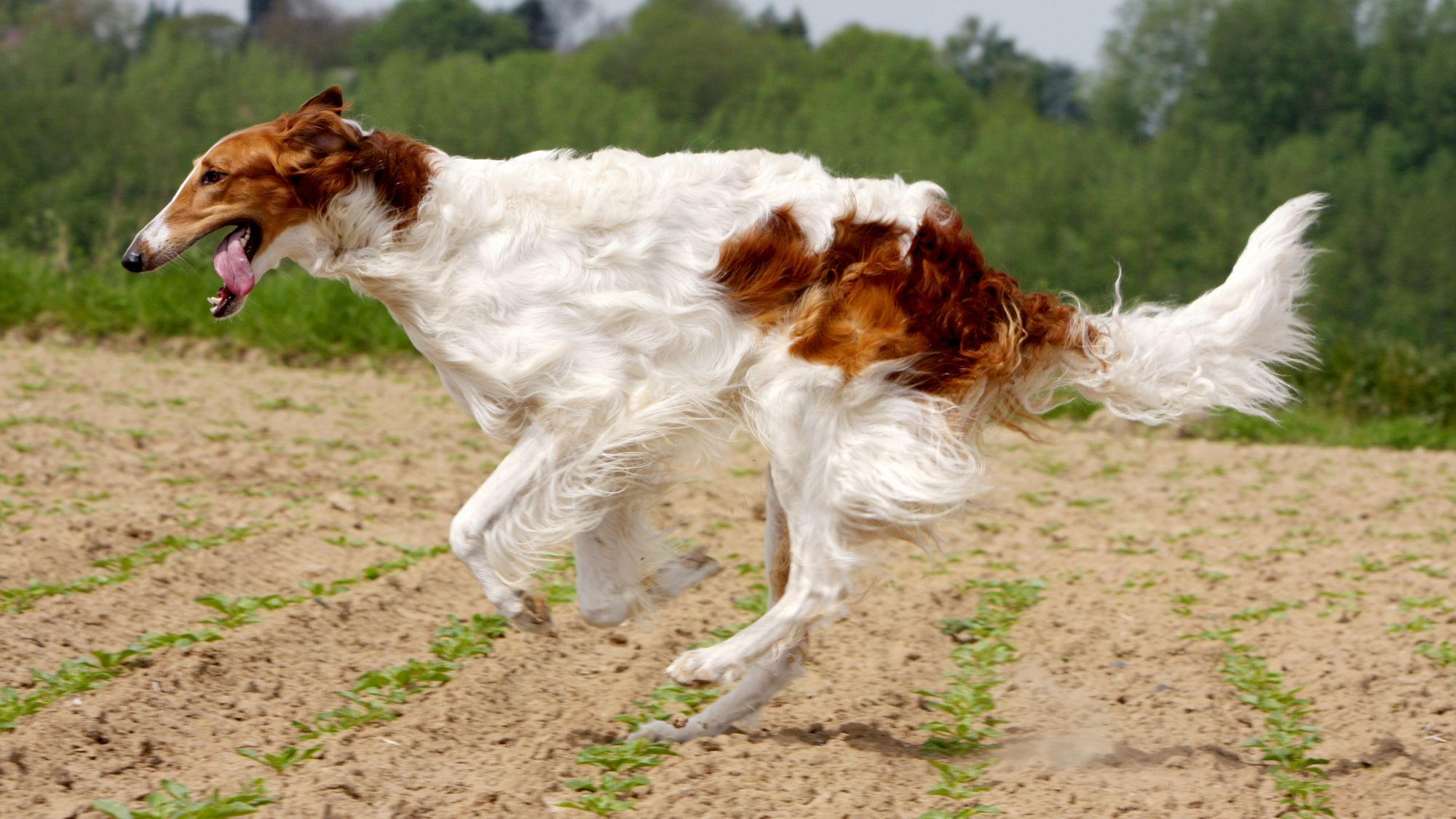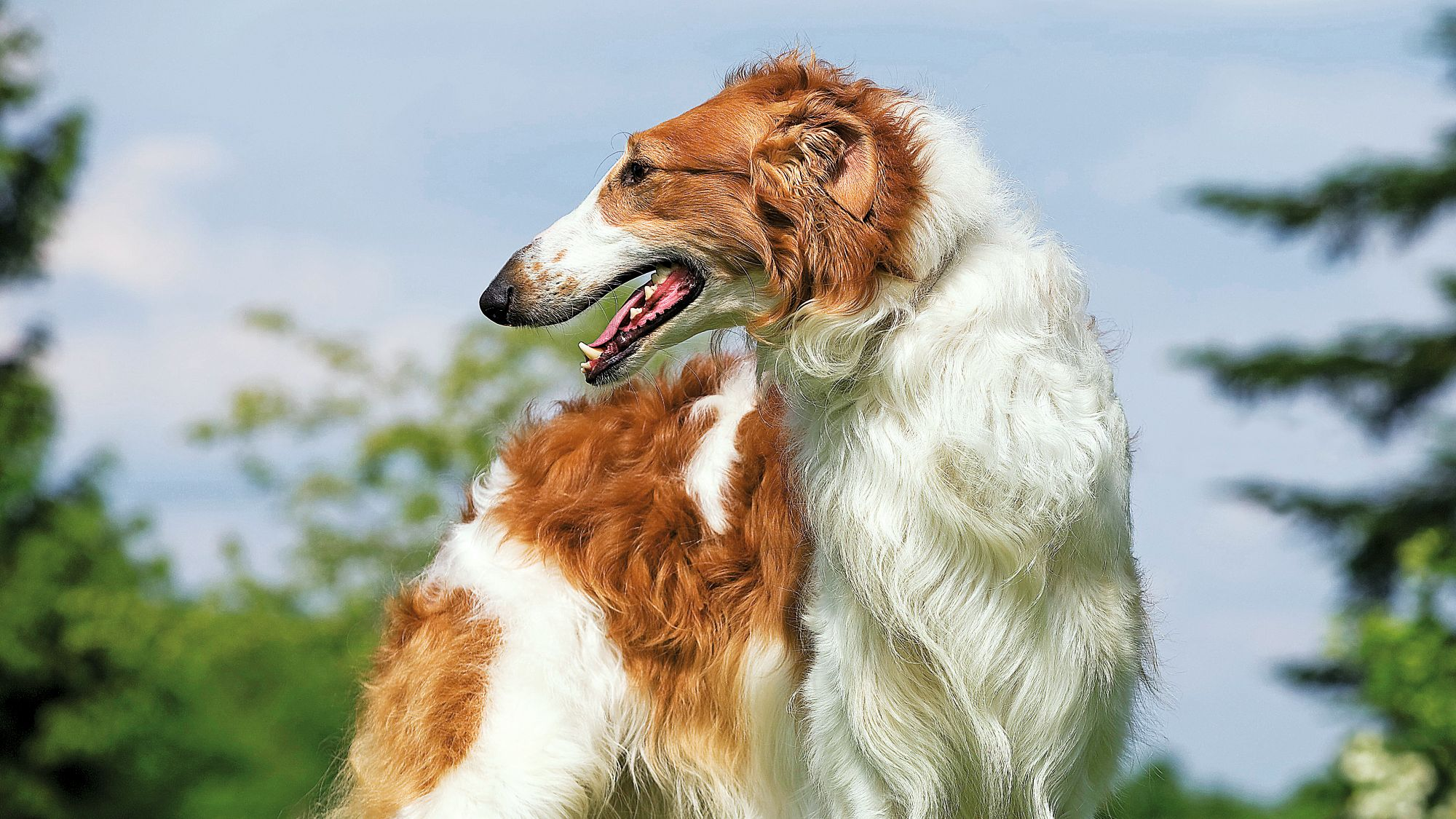Let's talk Borzois
Stately, graceful, and poised, the Borzoi was originally bred by Russian nobility to chase down prey on extravagant hunting expeditions. The Borzoi is a sighthound with a full coat of lustrous hair and a lean, muscular body that can sprint at up to 40 miles an hour (64km/h). Their impressive, streamlined build rightly suggests rare athletic prowess; however, there’s much more to the Borzoi than speed. Behind their innate elegance, the Borzoi is a sweet, affectionate breed and, with the right training, can become a wonderful family companion.
Official name: Borzoi
Other names: Russian Wolfhound, Russkaya Psovaya Borzaya
Origins: Russia
Drooling tendencies
{score 0 out of 5}Shedding Level
{score 0 out of 5}Energy level
{score 0 out of 5}Compatibility with other pets
{score 0 out of 5}Warm weather
{score 0 out of 5}Suited to apartment living
{score 0 out of 5}Family pet
{score 0 out of 5}Can stay alone
{score 0 out of 5}
| Male | Female |
|---|---|
| Height | Height |
| 73 - 81 | 66 - 78 |
| Weight | Weight |
| 34 - 48 | 27 - 39 |
| Adult | |
|---|---|
| 15 months to 5 years | |
| Mature | Senior |
| 5 to 8 years | from 8 years |
| Baby | |
| Birth to 2 months | |
Drooling tendencies
{score 0 out of 5}Shedding Level
{score 0 out of 5}Energy level
{score 0 out of 5}Compatibility with other pets
{score 0 out of 5}Warm weather
{score 0 out of 5}Suited to apartment living
{score 0 out of 5}Family pet
{score 0 out of 5}Can stay alone
{score 0 out of 5}
| Male | Female |
|---|---|
| Height | Height |
| 73 - 81 | 66 - 78 |
| Weight | Weight |
| 34 - 48 | 27 - 39 |
| Adult | |
|---|---|
| 15 months to 5 years | |
| Mature | Senior |
| 5 to 8 years | from 8 years |
| Baby | |
| Birth to 2 months | |

Get to know the Borzoi
All you need to know about the breed
The canine embodiment of grace and beauty, the Borzoi was originally bred by Russian aristocracy as a hunting and coursing dog, prized for their speed and agility. One of the tallest sighthound breeds, the naturally aristocratic Borzoi may look like it belongs in an 18th-century oil painting of a royal hunt; however, the affectionate Borzoi would much rather be with their human families.
As for their appearance, the Borzoi is tall and narrow with long, muscular limbs that ooze elegance with every move. Thanks to the Borzoi’s silky double coat that comes in all colors and varies from straight to wavy to full-on curly, the breed does well in cold weather—not surprising considering they were bred to endure frigid Russian winters. While Borzois do require consistent grooming, they actually clean their own coats much like cats do. Can we get a meow with that bark?
Intelligent and calm, the Borzoi can be stubborn. Firm but gentle training given with natural authority will get the best results. A one-family kind of dog, the Borzoi is neutral if not friendly with strangers. To ensure their best behavior around small children and other animals, it’s best to socialize your Borzoi as early as possible.
And while the Borzoi adapts well to indoor life, their sofa-surfing should be counterbalanced with plenty of regular exercise. Just remember: the Borzoi is prone to chase at every opportunity. Your Borzoi should remain on a leash in unfenced areas. They can always satisfy their need for speed in a secure, enclosed space!

2 facts about Borzois
1. Eye see you over there!
The Borzoi is a sighthound, a term that refers to the breed’s impressive vision. The Borzoi breed’s forward-facing eyes afford them a 270-degree sight range, which leaves humans’ 180-degree field of vision in the dust! Borzois also have a line of vision cells across their retina known as a vision streak. This trait, found only in sighthounds, retrievers and certain hunting dogs, enables the Borzoi to spot prey from great distances.
2. Flirting with Fame
The Borzoi has enjoyed several “fifteen minutes of fame” over the years. The captain of the ill-fated Titanic owned a Borzoi, though, luckily, the pooch wasn’t aboard when catastrophe struck. The Borzoi was also a favorite canine companion during the Art Deco movement thanks to their elegant looks and could be seen alongside stars like Jean Harlow and Sara Bernhardt as well as in the pages of Vogue. And let us not forget Nobs, the Borzoi who rose to rock star status by laying the “vocal” track for Pink Floyd’s 1971 song entitled “Mademoiselle Nobs”.
History of the breed
The Borzoi breed can be traced back to 17th-century Russia, where nobles crossed Arabian greyhounds with Russian sheep dogs to produce a fast, impervious-to-weather breed capable of chasing down and tackling rabbits, foxes and wolves. These lavish, large-scale hunts were a cherished tradition of Russian nobility for centuries involving up to one hundred Borzois and just as many servants.
The emancipation of Russian serfs in 1861 meant such large-scale hunting expeditions were no longer possible and the Borzoi population sharply declined. Soon afterward, the breed’s connection to the aristocracy proved lethal as many met the same demise as their owners after the Russian Revolution of 1917.
Luckily, the Borzoi was spared from extinction thanks to a few dogs offered as gifts to royals overseas and others imported by foreigners, namely in Britain and America, where breeding programs were soon established.
First registered by the AKC in 1891, the Borzoi was still known to the English-speaking world as the Russian Wolfhound. However, this changed in 1936, when it was decided to rename them Borzoi, after the Russian word “borzii”, meaning swift.
From head to tail
Physical characteristics of Borzois
1.Head
2.Ears
3.Body
4.Coat
5.Tail

Things to look out for
From specific breed traits to a general health overview, here are some interesting facts about your Borzoi
Prevention is the best medicine
Methemoglobinemia, a disease in which excessive levels of methemoglobin (caused by a cytochrome-b5 reductase deficiency) prevent the body from getting sufficient oxygen, has been detected in certain dog breeds including the Borzoi. While the disease is fairly rare and not life-threatening, it can result in a rapid breathing rate, cyanosis (bluish appearance in the mucous membranes resulting from an oxygen deficiency) and an exercise intolerance. Methemoglobinemia is inherited and can be diagnosed through genetic and laboratory testing. Your vet can provide more information on the condition, signs to look out for, and how to best care for your Borzoi.
Insight on PRA
Borzois can suffer from a group of inherited retinal diseases grouped under the acronym PRA, which stands for Progressive Retinal Atrophy. PRA involves the progressive degeneration of the retina and, if left unchecked, can lead to blindness. Fortunately, responsible breeders regularly screen their breeding stock for a number of conditions including PRA. And to ensure your Borzoi’s healthy vision, it’s always a good idea to have a regular eye exam done by a veterinary ophthalmologist.
Healthy diet, healthier dog
When choosing food for a Borzoi, there are many factors to consider: their age, lifestyle, activity level, physiological condition, and health including potential sickness or sensitivities. Food provides energy to cover a dog’s vital functions, and a complete nutritional formula should contain an adjusted balance of nutrients to avoid any deficiency or excess in their diet, both of which could have adverse effects on the dog.
Clean and fresh water should be available at all times to support good urinary regularity. In hot weather and especially when out exercising, bring water along and give your dog frequent water breaks.
Energy intake may also have to be adapted to the climatic conditions. A dog that lives outdoors in winter will have increased energy requirements.
The following recommendations are for healthy animals. If your dog has health problems, please consult your veterinarian who will prescribe an exclusively veterinary diet.
A Borzoi puppy’s requirements, in terms of energy, protein, minerals and vitamins, are much greater than those of an adult dog. They need energy and nutrients to maintain their body, but also to grow and build it. Until they are 15 months old, a Borzoi puppy’s immune system develops gradually. A complex of antioxidants—including vitamin E—can help support their natural defenses during this time of big changes, discoveries, and new encounters. Their digestive functions are different from those of an adult Borzoi, too: their digestive system is not mature yet so it is important to provide highly-digestible proteins that will be effectively used. Prebiotics, such as fructo-oligosaccharides, support digestive health by helping balance the intestinal flora, resulting in good stool quality.
It is important to choose a kibble with an appropriate size, shape, and texture. This growth phase also means moderate energy needs. Large-breed puppies, such as Borzoi puppies, whose growth period is long and intense, are especially susceptible to skeletal and joint problems, including limb defects, bone deformities, and joint lesions. The first part of growth is mainly concerned with bone development, although the muscles also start to grow. This means that a puppy that eats too much (takes in too much energy) will put on too much weight and grow too quickly. Limiting the energy concentration of a food for Borzoi puppies and feeding a correct daily amount will help control the speed of growth and minimize these risks.
Concentrations of other nutrients should be higher than normal in a specially formulated growth food. Although the calcium content in the food needs to be increased, maxi-sized breed puppies are more sensitive to excessive calcium intake. It’s important to understand that adding any ingredients to a complete food formulated for the growth phase is at best unnecessary and at worst dangerous for the animal, unless prescribed by a veterinarian. It is recommended to split the daily allowance into three meals a day until they are 6 months old, then to switch to two meals per day.
Throughout their life, it is important to avoid feeding Borzois human foods or fatty snacks. Instead, reward them with kibble taken from their daily meal allowance, and strictly follow the feeding guidelines written on the package in order to prevent excessive weight gain.
The main nutritional goals for adult Borzois are:
Maintaining an ideal body weight by using highly-digestible ingredients and keeping the fat content at a sensible level.
Helping support the health of their bones and joints with glucosamine, chondroitin, and antioxidants.
Promoting optimal digestibility with high-quality protein and a balanced supply of dietary fiber
Helping preserve the health and beauty of the skin and coat with the enriched addition of essential fatty acids (especially EPA and DHA), essential amino acids, and B vitamins.
After 5 years old, Borzois will start facing the first signs of aging. A formula enriched with antioxidants will help maintain their vitality, and specific nutrients, such as chondroitin and glucosamine, will help support healthy bones and joints. Aging is also accompanied by the modification of digestive capacities and particular nutritional requirements, so food for older Borzois should have the following characteristics:
Higher vitamin C and E content. These nutrients have antioxidant properties, helping to protect the body’s cells against the harmful effects of the oxidative stress linked to aging.
High-quality protein. Contrary to a widely held misconception, lowering the protein content in food brings little benefit in limiting kidney failure. In addition, older dogs are less efficient at using dietary protein than younger dogs. Reducing the phosphorus content is a good way of slowing down the gradual deterioration of kidney function.
A higher proportion of the trace elements iron, zinc, and manganese to help keep the skin and coat in good condition.
A higher quantity of polyunsaturated fatty acids to help maintain the quality of the coat. Dogs can normally produce these fatty acids, but aging can affect this physiological process.
As they age, dogs are increasingly prone to teeth problems. To ensure they continue to eat enough, the shape, size, and texture of their kibble needs to be tailored to their jaws.

Caring for your Borzoi
Grooming, training, and exercise tips
7/7
All about Borzois
The Borzoi is a natural sprinter-chaser and will tend to see other animals such as cats as potential prey. This is where early training and exposure to cats is key and will determine the outcome of their cohabitation.
Borzois should get regular exercise, affection, and grooming—just like countless other breeds. That said, the Borzoi is generally laid back and not particularly high maintenance. Looks can be deceiving.
Suggested Breeds
Read more on this topic
Sources
- Veterinary Centers of America https://vcahospitals.com/;
- Royal Canin Dog Encyclopaedia. Ed 2010 and 2020
- Banfield Pet Hospital https://www.banfield.com/
- Royal Canin BHN Product Book
- American Kennel Club https://www.akc.org/
Like & share this page